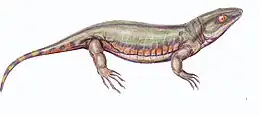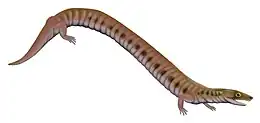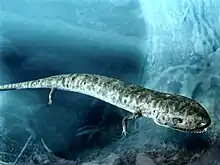Tuditanomorpha
Tuditanomorpha is a suborder of microsaur lepospondyls. Tuditanomorphs lived from the Late Carboniferous to the Early Permian and are known from North America and Europe. Tuditanomorphs have a similar pattern of bones in the skull roof. Tuditanomorphs display considerable variability, especially in body size, proportions, dentition, and presacral vertebral count. Currently there are four families of tuditanomorphs, with two being monotypic. Tuditanids first appear in the Lower Pennsylvanian. Goniorhynchidae, Hapsidopareiidae, and Trihecatontidae appear in the Late Pennsylvanian and Early Permian.[1]
| Tuditanomorpha Temporal range: Late Carboniferous—Early Permian | |
|---|---|
 | |
| Tuditanus punctulatus | |
| Scientific classification | |
| Domain: | Eukaryota |
| Kingdom: | Animalia |
| Phylum: | Chordata |
| Subclass: | †Lepospondyli |
| Order: | †Microsauria |
| Suborder: | †Tuditanomorpha Carroll and Gaskill, 1978 |
| Families | |
Gymnarthrids, pantylids, and Ostodolepidae, originally considered in the Tuditanomorpha, were later placed in the group Recumbirostra.[2][3][4] Asaphestra, previously thought to be the member of Tuditanomorpha, was reclassified as primitive synapsid in 2020.[5]
Classification
Suborder Tuditanomorpha
- Family Goniorhynchidae
- Family Hapsidopareiidae
- Family Trihecatontidae
- Family Tuditanidae
References
- Carroll, R. L.; Gaskill, P. (1978). "The Order Microsauria". Memoirs of the American Philosophical Society. 126.
- J. D. Pardo, M. Szostakiwskyj, P. E. Ahlberg and J. S. Anderson (2017). "Hidden morphological diversity among early tetrapods". Nature. 546: 642–646.
{{cite journal}}: CS1 maint: multiple names: authors list (link) - J. S. Anderson (2007). "Incorporating ontogeny into the matrix: A phylogenetic evaluation of developmental evidence for the origin of modern Amphibians. In J. S. Anderson, H.-D. Sues (eds.),". Major Transitions in Vertebrate Evolution: 182–227.
- A. K. Huttenlocker, J. D. Pardo, B. J. Small and J. S. Anderson (2013). "Cranial morphology of recumbirostrans (Lepospondyli) from the Permian of Kansas and Nebraska, and early morphological evolution inferred by micro-computed tomography". Journal of Vertebrate Paleontology. 33: 540–552. doi:10.1080/02724634.2013.728998.
{{cite journal}}: CS1 maint: multiple names: authors list (link) - A. Mann, B. M. Gee, J. D. Pardo, D. Marjanović, G. R. Adams, A. S. Calthorpe, H. C. Maddin and J. S. Anderson (2020). "Reassessment of historic 'microsaurs' from Joggins, Nova Scotia, reveals hidden diversity in the earliest amniote ecosystem". Papers in Palaeontology. 6 (4): 605–625. doi:10.1002/spp2.1316.
{{cite journal}}: CS1 maint: multiple names: authors list (link)

